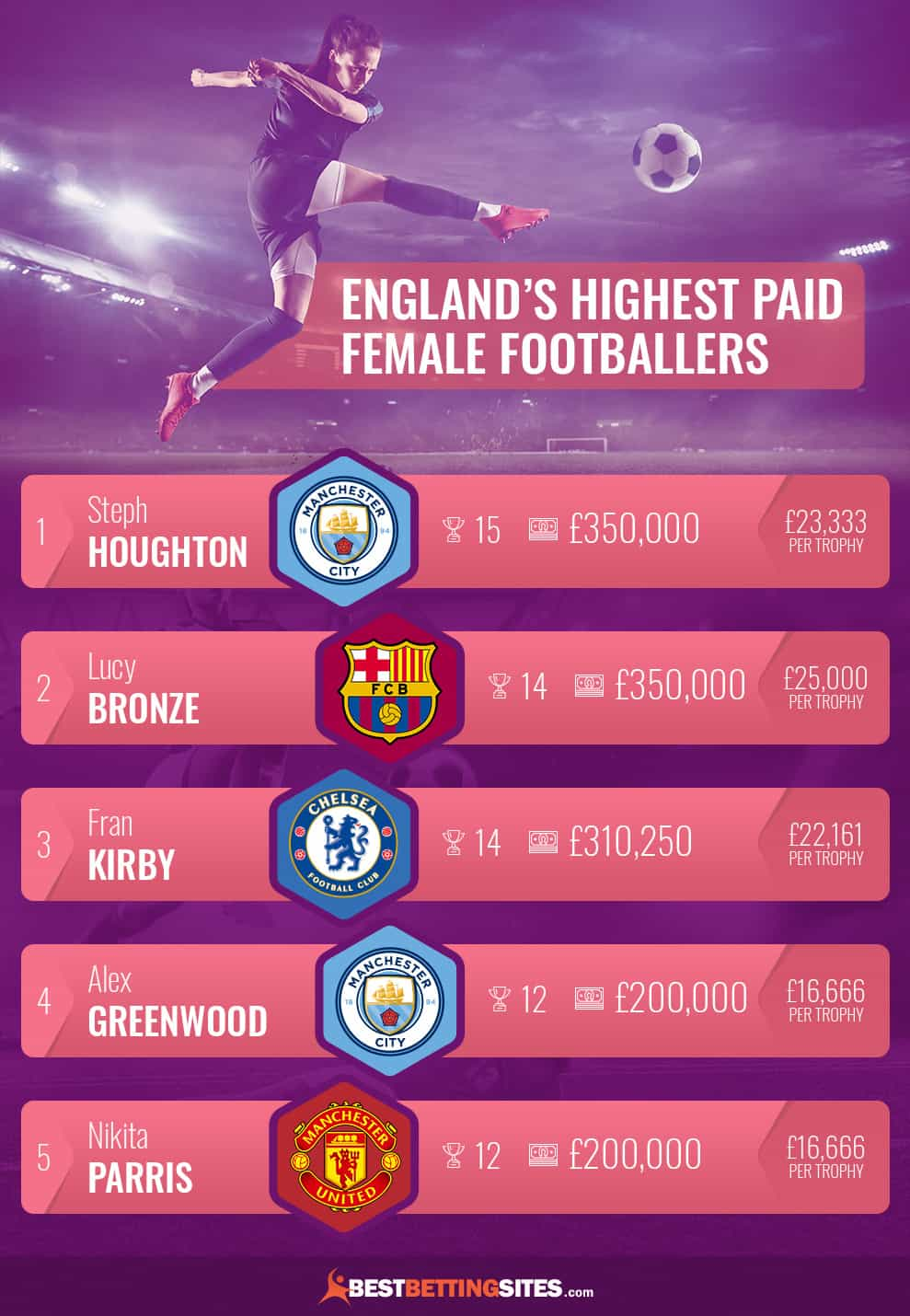The Highest Paid Female Footballer – The Top Five Earners
Women’s football has seen increasing recognition and financial rewards in recent years, with female players breaking through the glass ceiling and earning salaries previously unimaginable. In this blog, we look at the top highest-paid female footballers globally, with brief profiles of each player and their achievements in the sport. We also focus on England’s top highest-paid female footballers, exploring their impact on women’s football in the country. Additionally, we discuss the ongoing gender pay gap in football and initiatives to address the imbalance.

In recent years, there has been a surge in the popularity of women’s football as a sport, and with the Women’s World Cup starting in July, interest in the ladies’ game has never been higher in modern times.
The women’s sport has long been overshadowed by male competition, with female players receiving lower salaries and fewer sponsorship opportunities and endorsements opportunities. However, this is changing, and female footballers are beginning to receive the recognition and financial rewards they deserve.
One significant indication of this shift is the increasing salaries of female footballers.
In 2021, the highest-paid female footballer, according to Forbes, was Alex Morgan, who earned £3,719,974 the previous year. This amount may seem small compared to the earnings of male footballers, but it is a significant increase in the amount females earned in the sport a decade ago.
The increase in revenue of the female sport can be attributed to several factors;
First, the success of the Women’s World Cup in recent years has brought greater attention to the sport and the players involved. The increased exposure has led to more interest from fans and sponsors, resulting in more financial investment in the sport.
The definition of route one football. ⚡️👏#FIFAWWC
— FIFA Women’s World Cup (@FIFAWWC) March 30, 2023
Second, the growth of women’s football has led to the formation of more professional leagues worldwide. The creation of these leagues has provided female players with more opportunities to play professionally. In addition, engaging in numerous opportunities means players can earn income from salaries and sponsorship deals.
Finally, there has been a concerted effort from football’s governing bodies to promote and invest in women’s football. For example, FIFA has pledged to invest £807 million in women’s football over the next four years, demonstrating a commitment to growing the sport and providing female players with the recognition and financial rewards they deserve.
The increasing recognition and financial rewards in women’s football are a positive sign for the future of the sport. While there is still a long way to go level up to the men’s game in terms of quality and revenue, the progress made in recent years is significant.
Global Overview Of The Highest-Paid Female Footballers
Women’s football has grown in popularity in recent years, and with that growth comes an increase in salaries for female footballers. Here’s a global overview of the highest-paid female footballers, including their positions, clubs, wages, and achievements.
Sam Kerr – Australian
The Australian striker is currently the highest-paid female footballer in the world, earning a reported £417,000 annually. Kerr plays for Chelsea FC in the English Women’s Super League. She has won numerous awards throughout her career, including the Golden Boot for the Women League five times and the National Women’s Soccer League three times. The maestro has 48 goals in 95 appearances for her national team.
FULL-TIME SCENES!! pic.twitter.com/ltjORh4k2F
— Chelsea FC Women (@ChelseaFCW) March 30, 2023
Vivianne Miedema – Dutch
The Dutch forward plays for Arsenal F.C. in the English Women’s Super League and is the second-highest-paid female footballer in the world, earning a reported £382,500 per year. Miedema has won the Golden Boot in the English Women’s Super League and the Dutch Eredivisie. The maestro scored 69 goals in 91 appearances for the Netherlands national team, a standing record.
Alex Morgan – American
The American forward, who plays for the Orlando Pride in the National Women’s Soccer League, earns a reported £340,000 annually. Morgan has won numerous accolades throughout her career, including two Olympic gold medals, and has scored 116 goals in 180 United States national team appearances.
Fran Kirby – English
The English forward plays for Chelsea FC in the English Women’s Super League and earns a reported £310,250 annually. Kirby has won multiple titles with Chelsea, including the F.A. Women’s Cup and the UEFA Women’s Champions League. She has also won the Women’s PFA Player of the Year award and has scored 16 goals in 48 appearances for the England national team.
Pernille Harder – Danish
The Danish forward plays for Chelsea FC in the English Women’s Super League and earns a reported £301,750 annually. Harder has won multiple awards throughout her career, including the UEFA Women’s Player of the Year award, and has scored 71 goals in 122 appearances for the Denmark national team.
Pernille Harder vs United 🔥 Conti Cup 21/22 02/02/22 #CFCW #ChelseaFCW #PernilleHarder #ContiCup #WSL pic.twitter.com/vJScayUzbA
— ChelseaFCW Goals (@ChelseaFCWGoals) April 14, 2022
These female footballers have achieved significant success on the field and significantly impacted the sport. Their talent and dedication have helped to increase the visibility and recognition of women’s football worldwide. As their salaries continue to rise, it’s clear that the future is bright for female footballers around the globe.
England’s Highest-Paid Female Footballers
The English Women’s Super League (WSL) has become one of the top leagues in the world. We will take you through the top five highest-paid female footballers in England, their profiles, positions, clubs, and salaries, highlighting their achievements and impact on women’s football in England. But first, let’s dive into how much money women England football players earn.

Steph Houghton – Defender – Manchester City Women – Salary: £350,000
Houghton is the captain of Manchester City Women and the England national team. She is considered one of the best defenders in the world and has been instrumental in the Citizen’s women’s team’s success in recent years. She has won the Women’s Super League four times with Manchester City, F.A. Women’s Cup, and F.A. Women’s Super League Cup. Houghton has also been named in the PFA Women’s Team of the Year five times and was awarded an MBE for services to football in 2016. She is one of the highest-paid female footballers in England.
10th year… wow! 💙🫶🏻 https://twitter.com/mancity/status/1609491124921700353
— Steph Houghton MBE (@stephhoughton2) January 1, 2023
Lucy Bronze – Defender – Manchester City Women – Salary: £350,000
Bronze, one of the highest-paid female footballers in the UK, is another key player for Manchester City Women and the England national team. She is a versatile defender who can play anywhere in the backline and has been crucial to Manchester City’s success. The maestro has won numerous accolades, including the UEFA Women’s Player of the Year in 2019, and has been named in the PFA Women’s Team of the Year five times. In addition, she won the Women’s Super League thrice with Manchester City and was a crucial player in Lyon’s treble-winning team in 2020.
Fran Kirby – Forward – Chelsea Women – Salary: £310,250
Kirby is a forward for Chelsea Women and the England national team. She is a prolific scorer who has won numerous awards and accolades in her career. Kirby has won the Women’s Super League twice with Chelsea and the F.A. Women’s Cup and F.A. Women’s Super League Cup. In addition, she has been named the PFA Women’s Team of the Year four times and was the Women’s Footballer of the Year in 2017.
In conclusion, these five female footballers are not only the highest-paid in England but also some of the best players in the world. They have been instrumental in the growth of women’s football in England and have inspired young girls to pursue the sport.
Alex Greenwood – Defender – Manchester City Women – Salary: £200,000
Greenwood is a left-back for Manchester City Women and the England national team. She joined Manchester City in 2020 from Lyon and has been a critical player for the team ever since. Greenwood has won the Women’s Super League, the F.A. Women’s Cup with Manchester City, and the Women’s Champions League twice with Lyon. In addition, she has been named in the PFA Women’s Team of the Year twice and was the captain of the England Under-23 team that won the Nordic Cup in 2011.
These two were rock-solid for @ManCityWomen this #WomensFootballWeekend 💪#BarclaysWSL @stephhoughton2 @AlexGreenwood pic.twitter.com/IuY3eRnBBg
— Barclays Women’s Super League (@BarclaysWSL) March 28, 2023
Nikita Parris – Forward – Manchester United Women – Salary: £200,000
Parris is a forward for Manchester United and the England national team. She joined in 2022, having previously played for rivals Arsenal, who she signed for in 2020 from Lyon and has been a prolific scorer ever since. Parris has won the Women’s Super League twice with Manchester City and the Women’s Champions League with Lyon. She has been named in the PFA Women’s Team of the Year three times and was the top scorer in the Women’s Super League in the 2018-19 season.
Men v Women Footballers – The Reasons for the Gender Pay Gap
Women’s football has come a long way in recent decades, with increasing recognition, funding, and media coverage. However, the gender pay gap in football is still prevalent, with female players earning significantly less than their male counterparts.
For example, Lucy Bronze, the highest-paid female footballer in England, reportedly earns £350,000 per year playing for Manchester City. However, this pales in comparison to the salaries of male footballers in the Premier League, some of whom make more than that amount in just a week.
The discrepancy between the salaries of male and female footballers is due to a combination of factors, including differences in revenue and sponsorship deals. Men’s football has a much larger global audience and generates significantly more revenue than women’s football, which means that male footballers can command higher salaries. Additionally, male footballers are more likely to secure lucrative sponsorship deals and endorsements, increasing their earnings.
In England, the Women’s Super League (WSL) has seen a significant increase in funding and support in recent years, with more clubs investing in their women’s teams and securing a multi-million-pound sponsorship deal with Barclays. The aim of such colossal investment has improved the quality of the league and the players, increasing media coverage and fan engagement to try to match the parameters to the men’s game and hope it can match up the significance.
Sponsorship deals
One significant factor in the gender pay gap is sponsorship deals. Male footballers are more likely to secure lucrative sponsorship deals and endorsements, which can significantly increase their earnings, mainly because of the larger global audience for men’s football, which attracts more commercial interest and investment. However, there are also gender biases at play in the sponsorship market, with female athletes often receiving less lucrative deals than male athletes of similar ability and profile.
Diverse League
Another factor that contributes to salary discrepancies is the structure of different leagues. For example, England’s Women’s Super League (WSL) has seen a significant increase in funding and support in recent years. As a result, more clubs are investing in their women’s teams. In addition, the league is securing a multi-million-pound sponsorship deal with Barclays, which has significantly improved the quality of the company and the players, leading to increased media coverage and fan engagement.
The assist queen 👑@guro_reiten has provided more assists than any other player in the #BarclaysWSL this season ✨@ChelseaFCW pic.twitter.com/A9TOO8VRB2
— Barclays Women’s Super League (@BarclaysWSL) March 31, 2023
As a result, the highest-paid female footballers in England are now earning relatively high salaries compared to their counterparts in other countries.
Financial investment
In contrast, the lack of investment and support for women’s football in other parts of the world has led to lower salaries for female footballers. For example, in countries such as France and Spain, the women’s leagues are less well-funded and well-supported than the men’s leagues, which means that female players have fewer opportunities to earn high salaries. It’s not just an issue of league structures but also reflects broader societal attitudes towards women’s sports and female athletes.
Marketing strategies
Marketability is also a significant factor in the gender pay gap. Female footballers deemed more marketable or commercially attractive are more likely to secure high-paying deals and endorsements. Again, it can be influenced by appearance, personality, and social media following, impacting a player’s marketability. However, this can lead to a problematic situation where female footballers are valued more for their appearance and off-field persona than their on-field abilities.
Stakeholders Involvements
Addressing the gender pay gap in football will require a concerted effort from all stakeholders in the industry, including clubs, leagues, broadcasters, and sponsors, who must work together to promote and support women’s football at all levels. Which inversely increases investment in women’s football, improves the quality of the leagues and players, and promotes gender equality and inclusivity. Additionally, sponsors and advertisers must be more mindful of gender biases and ensure that female athletes are valued and rewarded on par with their male counterparts.
In conclusion, the gender pay gap in football is a complex issue influenced by various factors, including sponsorship deals, league structures, and marketability. While progress has been made in some countries, much work still needs to address this issue globally. By working together to promote and support women’s football, we can create a more equitable and inclusive industry that values female players for their talent, dedication, and achievements.
The Growth Of Women’s Football In The U.K.
One of the key drivers of growth in women’s football in the U.K. has been increased investment and support from governing bodies, clubs, and sponsors. The Football Association (F.A.) has invested heavily in women’s football recently, with initiatives such as the Women’s Football Development Programme and the introduction of a professional league for women.
The WSL, founded in 2011, has also received significant funding and support from the F.A. and sponsors such as Barclays, which signed a multi-million-pound deal to become the league’s title sponsor in 2019.
It’s time to vote for the @BarclaysFooty March Goal of the month!
🌟 @RachelRowe1323 🌟 Celin Bizet Ildhusøy 🌟 @samkerr1 🌟 @RachelDaly3 🌟 @Bethany_Eng15 🌟 @CaitlinFoord 🌟 @lauren__hemp
Vote now: https://ngx.me/5eIKqiM pic.twitter.com/fpuGtFv4t8
— Barclays Women’s Super League (@BarclaysWSL) March 31, 2023
This investment has improved the league’s and the players’ quality and increased media coverage and fan engagement. As a result, the WSL is now widely regarded as one of the world’s best women’s football leagues, attracting top talent from around the globe and producing high-quality matches broadcast on national television. The league’s success has also inspired more girls and women to take up football, with participation rates in the sport increasing yearly.
Another factor contributing to the growth of women’s football in the U.K. is the success of the England women’s national team. The team reached the semi-finals of the 2019 FIFA Women’s World Cup, which was held in France, and has consistently performed well in international competitions in recent years. The team’s success has helped to raise the profile of women’s football in the U.K. and has inspired more girls and women to get involved in the sport.
In addition to the national team and the WSL, several grassroots initiatives and community clubs are working to promote women’s football at a local level. These clubs provide opportunities for women and girls of all ages and abilities to play football and help to foster a sense of community and belonging.
Critical Moments In Women’s Football History
Women’s football has come a long way over the past few decades, with players enjoying better financial opportunities than ever before. The progress has resulted from many critical moments in the history of women’s football, from the first international match in 1892 to the introduction of professional leagues and increased investment in the sport.
One of the most critical moments in the history of women’s football was the first international match, which took place in 1892 between England and Scotland. This match helped to establish women’s football as a legitimate sport and paved the way for future competitions and events. Over the next few decades, women’s football grew in popularity, with matches drawing large crowds and even attracting royal patronage.
However, the 1921 Football Association ban on women’s football in England halted the sport’s progress, and it would take several decades for women’s football to regain its footing. In the 1970s and 1980s, women’s football experienced a resurgence with the formation of women’s football teams and the establishment of national and international competitions. The first Women’s World Cup was held in 1991, marking a significant milestone for the sport.
Today is a very important date in #WomensHistory… it’s the 100 year anniversary of the Football Association Ban on Women’s Football⚽️ You heard that correctly. The FA made it illegal for women to play on their grounds #OTD in 1921. To understand why let’s go back to WW1 1/7
— EastEndWomen’sMuseum (@EEWomensMuseum) December 5, 2021
The turn of the millennium saw a significant increase in investment in women’s football, with the establishment of professional leagues and more substantial financial support from governing bodies and sponsors. In 2009, the Football Association launched the Women’s Super League, England’s top-level league for women’s football. This move helped to raise the profile of women’s football and provided players with better financial opportunities, including salaries, bonuses, and sponsorship deals.
Another critical moment in the history of women’s football was the success of the England team at the 2015 Women’s World Cup, where they finished third overall. This success helped to generate more excellent media coverage and fan interest in women’s football, leading to increased revenues and investment in the sport. This success was built on at the 2019 Women’s World Cup, where England reached the semi-finals, cementing their status as one of the top teams in the world.
Things were even better in 2022 after the England women’s team won a major tournament, the first for either sex since 1966. A Chloe Kelly goal scored in extra time secured their triumph over Germany and turned the team into national heroes.
📅 1972: The first England Women’s International game is played
📅 2022: England win the Euros
Iconic from the #Lionesses🏆 pic.twitter.com/qD7y5cvHsS
— talkSPORT (@talkSPORT) July 31, 2022
The global pandemic has also impacted women’s football, with some leagues cancelled or delayed. However, many governing bodies and clubs have continued to invest in the sport, recognising its importance and potential for growth.
In conclusion, women’s football has come a long way over the past few decades, with players enjoying better financial opportunities.
This progress has resulted from many critical moments in the history of women’s football, from the first international match to the establishment of professional leagues and increased investment in the sport.
While there is still work to be done to achieve full gender equality in football, these pivotal moments have helped to pave the way for a brighter future for women’s football.
Don’t forget, the Women’s World Cup runs from Thu, Jul 20, 2023 – Sun, Aug 20, 2023.



